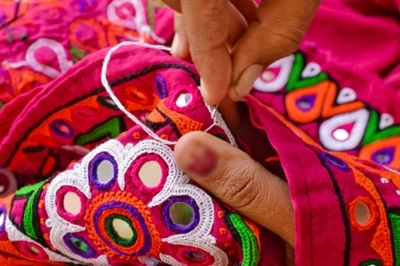Srinagar: Incredibly, the exquisite Kashmir handicrafts, which feed 3.25 lakh people, mostly in downtown Srinagar, and brings in an impressive Rs 2,000 crore every year to the valley, was not a priority area for the governments of the National Conference (NC), the Peoples Democratic Party (PDP) and the Congress party for over 20 years.
This is unmistakably clear, among many things, from the fact that none of these governments in the erstwhile State carried out labelling of even the seven Geographical Indication (GI) certified trades.
The process for GI-certification of several trades was started by Shariq Farooqi, Director Craft Development Institute (CDI), in 2010. In 2013, Jammu and Kashmir got GI certificate for Pashmina, Kani Shawl, Sozni embroidery, Papier Mache, Walnut carving and Khatamband ceilings. Subsequently, with the sustained efforts of the Indian Institute of Carpet Technology (IICT), J&K also got a GI tag for hand-knotted wool and silk carpets.
However, for reasons not known to anybody, necessary labelling for trading of the seven GI-certified products was never carried out. The result was that the whole exercise ended up as an exercise in futility, with the Kashmiri weavers, artisans and producers suffering. Eventually the market for fake and spurious products flourished all across the country and the Kashmir producers turned broke.
During President’s rule since 2019, the Department of Handicrafts and Handlooms has submitted dossiers for seven more trades, all endemic to the Valley, and also started the process of labelling. “We have now completed labelling of all GI-certified and non-GI certified trades. It will go a long way to boost the production, trade and export of the Kashmir handicrafts,” Director Handicrafts and Handlooms Kashmir, Mehmood Shah, told India Narrative.
“The main purpose of GI certification is to stop machine-made products that are being passed off as handicrafts and identify the real handicrafts. After GI tagging, anybody can check details and certification of a product on his smartphone. It will eventually end the market for fake products,” Shah explained.
“We have already submitted dossiers for GI certification of Kashmir Namda, Wagguv, Shikara, Gabba and Kashmir Willow Bat. In December 2022, we also submitted dossiers for two more trades—Chain Stitch and Crewel Embroidery—to Intellectual Property India (IPI), Chennai,” he added.
Another dossier for GI certification of Kashmir Tweed is currently under process and likely to be submitted to the IPI during this month.
IPI is an apex body for registration and better protection of geographical indications relating to goods in India. It functions under the supervision of the Controller General of Patents, Designs and Trade Marks which is part of the Department of Promotion of Industry and Internal Trade of the Union Ministry of Commerce and Industry.
The process of GI certification is conducted after a meticulously conducted verification of the documents and certificates and clearance of all observations in scheduled hearings by the IPI.
The Handicrafts Department is in the process of launching the QR-Code-based GI labelling of 6 crafts as QR-Code-GI labelling for Carpets was already initiated last year. Additionally, non-GI crafts are being brought under the ambit of QR code labelling in the current year.
While highlighting the significance of the GI certification of Crewel and Chain-stitch, Director Handicrafts said that his department was working hard to get more crafts from Kashmir under the ambit of GI certification so that the genuine handmade Kashmir Handicrafts would get due recognition across the globe.
According to Shah, more than 10,000 craftsmen associated with the twin crafts of Crewel and Chain-stitch were scattered over different districts of the Kashmir region and they all would get benefitted from the GI certification of these crafts. These crafts have an export potential of more than 200 crores, he added. The average aggregate annual turnover of the Kashmir handicrafts is currently between Rs 2,000 crore to Rs 2,200 crore. In J&K’s economy, horticulture, handicrafts and tourism are the key contributors.
In all, 3.25 lakh artisans are registered with the Department of Handicrafts and Handlooms in the Kashmir valley. “We are now in the process of the registration, recognition and GI certification of 24 unregistered crafts like stone chiselling (Kataas), Purzgar, Rafugar, Dyer etc. Once done, our population of registered artisans would rise to 5 lakh”, Shah said. In addition, there are nearly 30,000 artisans of Basohli Shawl and Basohli Paintings in the Jammu province.
Geographical indication tagging has acquired a greater significance ever since the focus has shifted towards Vocal for Local. The Handicrafts Department has been facilitating the promotion of GI-tagged products symbolising the empowerment of the artisans. Machine made products have implied a challenge to the entire Handicraft and Handloom sectors. The GI certification, according to the producers and the officers, would go a long way in preserving the crafts as well as facilitating buyers in making the purchase of genuine handmade products.
One significant success story in recent time for crewel and chain stitch has come from Noor Ari a women-led producer company which has collaborated with Fab India, an international brand to provide various crewel and chain stitch items. A large number of manufacturers, traders and exporters have approached the Department of Handicrafts for testing and labelling of the GI certified products. Traders say that many of the tourists and buyers from outside J&K are also insisting on GI tagging of the products they want to purchase.




















